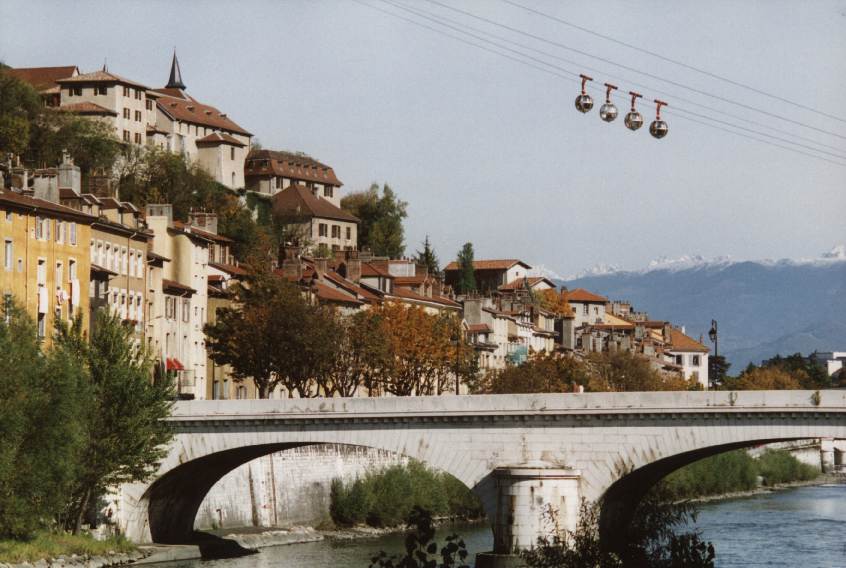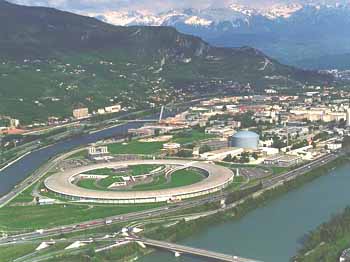GRENOBLE

Picture: 1999
Location
C
ontrary to what is sometimes thought,
although being surrounded by mountains ranging up to 10000ft,
Grenoble is not 'somewhere high in the mountains',
but at the bottom of a valley, at only 200m-high (600ft) above sea level...
And to completely dismantle the cliché, I must add that all the streets in the valley
itself are very flat. This is due to the fact that the valley,
initially carved by icecaps (during the quaternary geological period),
has been later filled up by materials brought by two converging rivers.
 The first river is named 'Isère', and as displayed in
the above picture, it is running directly through the historical center of Grenoble.
The second one is named 'Drac', and it is running 1-2km away from this center.
Several periods of economical growth have made the city of Grenoble progressively filling
up all the space between these two rivers. This filling was symbolically completed in the last 40 years
by the building of many research centers near the confluence point of the rivers, which ended recently
with the building of the European Synchrotron Radiation Facility
(ESRF) at the very confluence point (see the picture on the right,
taken from the ESRF Web site).
The first river is named 'Isère', and as displayed in
the above picture, it is running directly through the historical center of Grenoble.
The second one is named 'Drac', and it is running 1-2km away from this center.
Several periods of economical growth have made the city of Grenoble progressively filling
up all the space between these two rivers. This filling was symbolically completed in the last 40 years
by the building of many research centers near the confluence point of the rivers, which ended recently
with the building of the European Synchrotron Radiation Facility
(ESRF) at the very confluence point (see the picture on the right,
taken from the ESRF Web site).
Summary of history
T
he history of Grenoble
starts some time BC. There was then a village with a
Celtic name, 'Cularo'. Romans settled near the village in 43 BC, and the settlement grew
to a small town which which was renamed 'Gratianopolis' in 379 AD, in tribute to Emperor Gratian.
For a long time the city remained small despite the founding of a University as soon as 1339, and was mainly a garrison town. A period of continous growth was triggered in the mid-ninetenth century by the first setup near Grenoble of the first water-powered electricity plant (Aristide Bergès, 1869), called at that time white coal. Many industries settled in the vicinity, which lead to a five-fold increase of population between 1860 and 1960. The growth was then sustained by the hosting of many research centers, by the Olympic Winter Games in 1968, and later by microelectronics plants.
Nowadays
I
n 2003 there were about 400000 inhabitants in Grenoble and suburb, from which 160000
in the town itself. There are around 8000 researchers in the valley, and 56000 students in the University.
Links
- Official site of the city of Grenoble.
- Musée Dauphinois (Regional life and culture).
- Some research institutes : CNRS-Grenoble, CEA-Grenoble, ESRF, ILL.
- The Science University of Grenoble (UJF) and the Technical University of Grenoble (INPG).
- The mountain area Vercors,
south-east of Grenoble.
- Natural regional park
- An extensive site about Vercors, written by pupils and teachers.
- A private link
- Regional Park of Chartreuse (Mountain area north of Grenoble).
- Official pages of Chartreuse Natural Regional Park
- A private link.